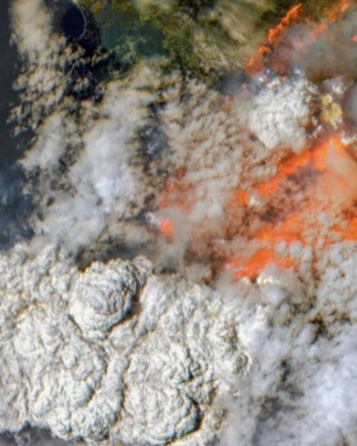Tech eyes to spy on fires
 Australia will soon use satellites and drones to spot bushfires when they break out.
Australia will soon use satellites and drones to spot bushfires when they break out.
Queensland-based company Fireball has announced it will launch the first purpose-built fire-detection satellite in Australia.
The launch is scheduled for about a year from now, sending up the first of a planned 24 satellites to monitor Australia from low Earth orbit.
A full system including ground-based cameras and aerial drones is in the works.
Fireball says the complete system should be able to spot any fires in Australia within one minute of ignition.
But there are some concerns about what is effectively automated surveillance over millions of square kilometres, and the vast amounts of data it will gather.
Currently, most bushfires in Australia are reported by cals to triple-0, or by observers in raised towers. Studies have shown an observer in a tower takes an average of 30 minutes between ignition and detection.
With local bushfires that can spread 1,500 square metres every 10 minutes, the response time needs to be reduced.
While the Fireball system will be expensive, the economic cost of not detecting fires within 30 minutes is estimated to be over $8 billion in destroyed property and fire-fighting costs over the next 30 years.
The satellite system is referred to as FUEGO: Fire Urgency Estimator in Geosynchronous Orbit. Fireball’s proprietary AI, called FUEGO Intelligence, can already process over one billion images per year from ground-based cameras as well as analysing more than 500,000 satellite images – one every 60 seconds.
Fireball’s FUEGO system is operating in the USA, monitoring over 125 million acres around the clock from Mexico to Canada covering California, Nevada, Oregon, Idaho, and Washington. In areas that are monitored, fires are detected and reported within minutes after ignition.
There is precedent for this kind of speed in Australia too, with tests by RMIT using photos from the Japanese weather satellite Himawari 8 photos to detect new fires in the 2019/20 bushfire season.
The system took just 60 seconds to process satellite photos and sound an alert, according to RMIT's Remote Sensing Research Group.
When it comes to actually fighting fires, Australian national university experts are working on a system of automated water-bombing drones that can drop a payload of water on very specific targets. The plan is to use drones to reach the target fast enough that only a small amount of water is needed to extinguish the fire.
Fireball evolved from research into exploding stars conducted at the Siding Spring Observatory in Australia by USQ Adjunct Professor Carl Pennypacker.
“It started with a supernova search at the Anglo Australian Telescope, and we later evolved our search to include other telescopes,” Professor Pennypacker said.
“But the challenge of finding smoke is not an easy one, and the same types of skills and passion we employed searching for bright spots in galaxies a billion light years across the Universe are very useful in finding 20 miles across the valley.”
But even with all this new technology and bold ideas, Australian fire services say they will be relying on old methods for some time.
NSW RFS manager of predictive services, Laurence McCoy, says the service is wary of too much automation.
“You can't rely on these systems solely,” he told reporters.
“You need people to interpret them,” he said, adding that someone also needs to be “on the ground” to confirm any reported fires.
Fireball is not waiting for the authorities to come around to the idea. It is running on a privatised model where the user pays for fire detection. It has already secured a deal with a Queensland plantation company. There is some concern about the system leading to unequal service, in which rich companies and areas are better protected than poorer, less-populated ones.
Australian space transport provider, Space Machines Company, has signed a customer agreement to deploy Fireball International’s first bushfire detection satellite into its final orbit on board Space Machines Company’s orbital transport, Optimus-1 in 2022.








 Print
Print